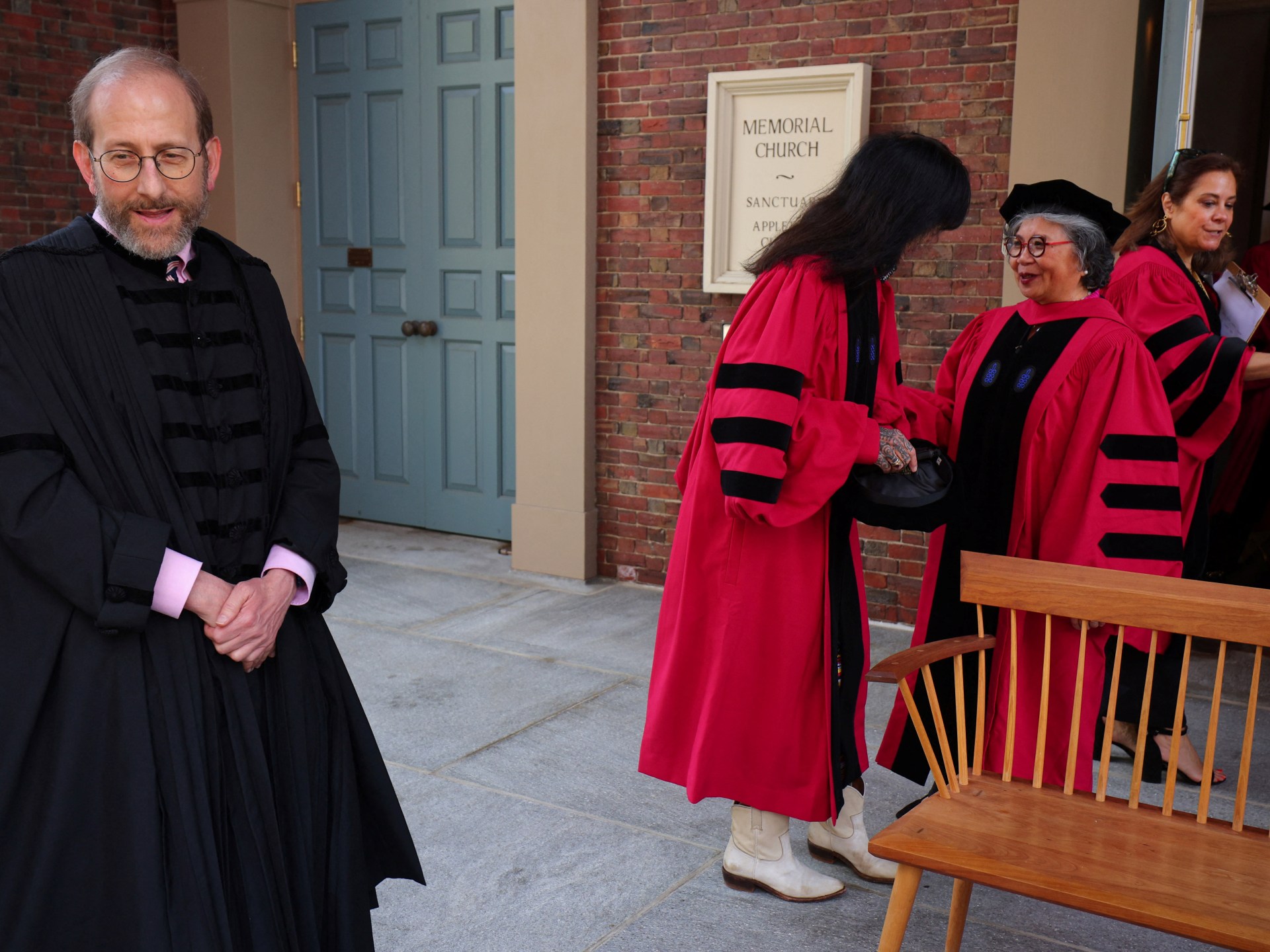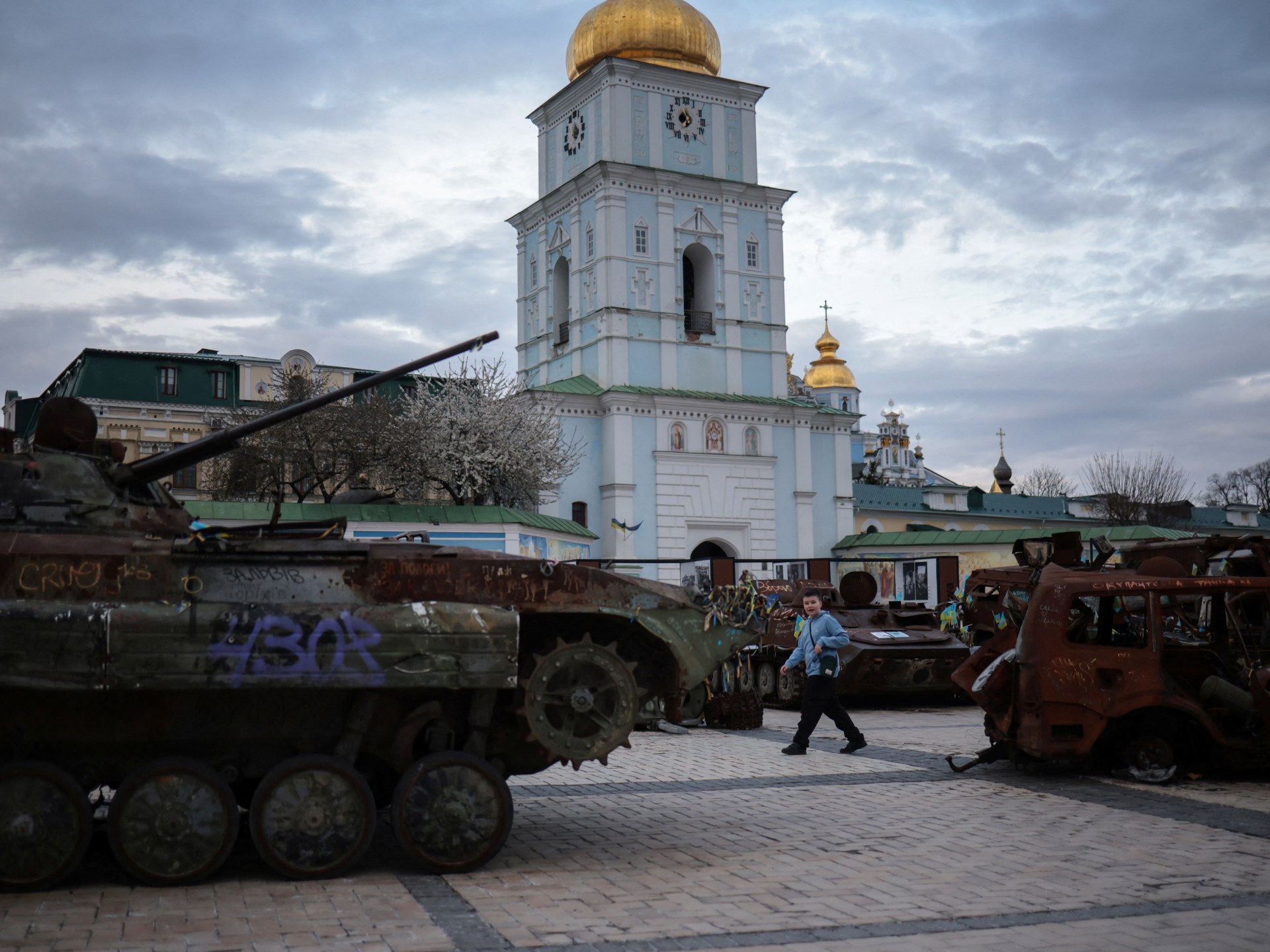Conflict Zones
Harvard’s $2.3bn gamble: What Trump demanded; how the university resisted | Donald Trump News

United States President Donald Trump’s campaign to pressure universities into dropping diversity, equity and inclusion measures and punishing student protesters has faced its strongest pushback yet when Harvard University rejected a series of demands from his administration.
Monday’s decision quickly prompted the US Department of Education to freeze nearly $2.3bn in federal funding for the Ivy League institution ranked among the best universities in the US.
In a response on his Truth Social platform on Tuesday morning, Trump accused Harvard of pushing “political, ideological, and terrorist inspired” notions rather than acting in the public interest.
So what happened between Harvard and Trump, and why did the institution risk billions of dollars to go against the administration’s demands?
What did the Trump administration ask Harvard to do?
The heads of the US Department of Education, Department of Health and Human Services, and the General Services Administration co-signed a letter to Harvard on Friday. In this letter, they claimed “Harvard has in recent years failed to live up to both the intellectual and civil rights conditions that justify federal investment.”
This was followed by a list of demands for the university in Cambridge, Massachusetts, to fulfil. Key among them were:
Promoting faculty committed to the Trump administration’s demands of Harvard, as articulated in the letter, and “reducing the power” of faculty and administrators “more committed to activism than scholarship”.
Ending all affirmative action in faculty hiring and student admissions by August. At the same time, the letter demanded that the university ensure “viewpoint diversity” by abolishing criteria during admissions and hiring processes “that function as ideological litmus tests”.
Changing the admissions process “to prevent admitting international students hostile to the American values”, including “students supportive of terrorism or anti-Semitism”. The letter did not define what it meant by “American values”. For the 2024-2025 academic year, there were 6,793 international students at Harvard, making up 27.2 percent of its total enrolment – up from less than 20 percent in 2006-2007.
Changing disciplinary policies and forbidding the recognition and funding of student groups or clubs that promote “criminal activity, illegal violence, or illegal harassment”.
Implementing a comprehensive mask ban with immediate, serious penalties for violation “not less than suspension” after some students have protested while wearing masks. The letter did not list any exceptions to this rule, such as health reasons.
Closing all diversity, equity, and inclusion (DEI) programmes and offices and carrying out organisational reform to ensure transparency with federal regulators.
Harvard was given a deadline of August to implement these changes. This is the second letter issued by the Trump administration to Harvard. The first one was issued on April 3 and called on Harvard to ban face masks and reform academic departments that it alleged were guilty of anti-Semitic bias. Charges of anti-Semitism have been levelled against numerous US universities and colleges since widespread campus protests were held against the war in Gaza.
How did Harvard respond to the demands?
Harvard’s lawyers responded to the Trump administration by saying the university rejected the demands, arguing they violated its First Amendment rights and freedoms recognised by the US Supreme Court. The US Constitution’s First Amendment upholds the rights to free speech, expression and assembly.
The university said Harvard strongly opposes anti-Semitism and continues to make structural changes to ensure that the institution is a welcoming and supportive learning environment for all students.
The university also published a separate letter online signed by President Alan Garber on Monday. In the letter, Garber said federal grants have led to research and innovation in fields pertaining to science and medicine. “These innovations have made countless people in our country and throughout the world healthier and safer,” he wrote.
The letter then referred to how the government had threatened to pull federal funding from several universities, including Harvard, over allegations of anti-Semitism on campus. The letter said the government retreating from its funding agreements with higher education institutions “risks not only the health and well-being of millions of individuals but also the economic security and vitality of our nation”.
The Harvard letter said that while some of the government’s demands are aimed at combating anti-Semitism, “the majority represent direct governmental regulation of the ‘intellectual conditions’ at Harvard.”
“The University will not surrender its independence or relinquish its constitutional rights,” Garber added.
The Harvard chapter of the American Association of University Professors filed a lawsuit on Friday in a federal court in Boston, accusing the Trump administration of “unlawful and unprecedented misuse of federal funding and civil rights enforcement authority to undermine academic freedom and free speech on a university campus”.
In his latest online post, Trump wrote, “perhaps Harvard should lose its Tax Exempt Status and be Taxed as a Political Entity if it keeps pushing political, ideological, and terrorist inspired/supporting ‘Sickness?’ Remember, Tax Exempt Status is totally contingent on acting in the PUBLIC INTEREST!”
What is the backdrop to this standoff?
In January 2024, Garber had set up presidential task forces on campus to combat anti-Semitism and fight bias against Muslims and Arabs as Israel’s war on Gaza raged, igniting tensions on campuses around the world, including in the US.
In April 2024, pro-Palestine protesters set up an encampment on the Harvard campus, called Harvard Out of Occupied Palestine (HOOP). The protesters demanded that Harvard divest from weapons companies and companies associated with Israel.
At that time, Garber said HOOP had disrupted educational activities on campus. In May, the university and protesters said they had reached an agreement to end the encampment, but the two parties gave different accounts about the terms of this agreement.
While the student protesters said Harvard had agreed to their demands, the university said it had only opened itself to dialogue on the demands. For example, pertaining to the students’ demand for the university to divest from companies with ties to Israel, Harvard said it had agreed to be more transparent with its students about how its endowment works.
How much federal funding could Harvard lose?
On Monday, hours after Harvard’s response, a task force created by the US Department of Education to tackle anti-Semitism released a statement announcing that $2.3bn in federal funding to the university had been frozen.
“Harvard’s statement today reinforces the troubling entitlement mindset that is endemic in our nation’s most prestigious universities and colleges – that federal investment does not come with the responsibility to uphold civil rights laws,” the statement said. The frozen federal funds to Harvard include $2.2bn in grants and $60m in contracts, the statement added.
However, more money is at stake – about $9bn. On March 31, the Education Department, Department of Health and Human Services and the General Services Administration released a statement warning they would review $255.6m in contracts between the federal government and Harvard and its affiliates. The statement added that they would also review more than $8.7bn in multiyear grant commitments to Harvard and its affiliates.
Harvard’s endowment amounted to $53.2bn in the 2024 fiscal year — the largest of any university. However, donors decide which programmes, departments and purposes 70 percent of the annual endowment distribution is spent on. Endowment donations also dropped by $151m in 2024 as several billionaire donors stopped funding the institution over its response to concerns over anti-Semitism on campus, the university’s student-run newspaper, the Harvard Crimson, reported in October.
How have things unfolded at other US universities?
While Harvard is the first university to reject the Trump administration’s demands, it is not the first Ivy League school to be targeted.
Last year, Columbia University in New York emerged as the epicentre of pro-Palestine campus protests. Protesters occupied a campus building, Hamilton Hall, on April 30. The university called in the New York Police Department to crack down on student protesters.
In February, the Trump administration pulled back Columbia’s federal funding, worth $400m, citing the institution’s “failure to protect Jewish students from anti-Semitic harassment”. In March, Immigration and Customs Enforcement (ICE) agents arrested Mahmoud Khalil, a recent Columbia graduate and protest leader who had negotiated with the university during the campus demonstrations. Days earlier, the US Department of State revoked the visa of Ranjani Srinivasan, who was an urban planning doctoral candidate at Columbia. Soon after, Columbia unenrolled Srinivasan, who flew to Canada before she could be deported.
On March 13, the government’s Joint Task Force to Combat Anti-Semitism issued a letter to Columbia with nine demands for negotiations to restore the funding that was pulled. On March 18, Columbia accepted the government’s demands, listed in a new memo. The memo said protesting students will have to present university identification if prompted. It added that face masks would be banned if they are being used to conceal a person’s identity. However, face coverings are still allowed for religious or medical reasons. The memo also added that Columbia had hired 36 security officers who have special powers to arrest students, and the university continues to rely on New York police for additional security assistance.
Over the past few weeks, the Trump administration has suspended or frozen funding for Princeton, Cornell and Northwestern universities. The universities have responded by expressing frustration and highlighting how federal funding is important for critical research.
On April 11, the US Department of Energy, which funds research at many universities, announced a universal cap on the indirect costs it would finance for projects it supports. The agency said this would save the government $405m a year.
Nine universities and three bodies representing higher education institutions have since filed a lawsuit challenging that cap. The plaintiffs in the case include the Association of American Universities, American Council on Education, Association of Public and Land-Grant Universities, Brown University, California Institute of Technology, Cornell University, Board of Trustees of the University of Illinois, Massachusetts Institute of Technology, the regents of the University of Michigan, Board of Trustees of Michigan State University, the trustees of Princeton University and the University of Rochester.
What are the reactions to Harvard’s dispute with Trump?
Vermont Senator Bernie Sanders congratulated Harvard on X on Monday “for refusing to relinquish its constitutional rights to Trump’s authoritarianism”.
Congratulations to Harvard for refusing to relinquish its constitutional rights to Trump’s authoritarianism.
Other universities should follow their lead.
And instead of doing pro bono work for Trump, cowardly law firms should be defending those who believe in the rule of law.
— Bernie Sanders (@BernieSanders) April 14, 2025
Former US President Barack Obama posted on Tuesday: “Harvard has set an example for other higher-ed institutions – rejecting an unlawful and ham-handed attempt to stifle academic freedom.”
Harvard has set an example for other higher-ed institutions – rejecting an unlawful and ham-handed attempt to stifle academic freedom, while taking concrete steps to make sure all students at Harvard can benefit from an environment of intellectual inquiry, rigorous debate and… https://t.co/gAu9UUqgjF
— Barack Obama (@BarackObama) April 15, 2025
Massachusetts Governor Maura Healey posted a statement on X congratulating Harvard for “standing against the Trump Administration’s brazen attempt to bully schools and weaponize the US Department of Justice under the false pretext of civil rights”.
My statement on @Harvard’s response to demands from the Trump Administration. pic.twitter.com/IYa7LSG7iX
— Maura Healey (@MassGovernor) April 14, 2025
Conflict Zones
Russia-Ukraine war: List of key events, day 1,150 | Politics News

These are the key events on day 1,150 of Russia’s war on Ukraine.
Here is where things stand on Saturday, April 19:
Fighting
Russia launched eight missiles and 87 drones in an overnight attack on Ukraine on Saturday, causing damage in five regions across the country, the Ukrainian air force said. Air defence units shot down 33 Russian drones while another 36 were redirected by electronic warfare. Damage was recorded in five regions in the south, northeast and east.
A Russian missile attack killed one person in Kharkiv, while a drone attack killed another in Sumy, with at least five children among dozens injured. Kharkiv Mayor Ihor Terekhov said 15 residential buildings, a business and an educational facility were damaged in the attack.
The city of Zaporizhzhia was hit by a Russian drone during the night. Regional Governor Ivan Fedorov reported the attack on Telegram, saying a fire had broken out and emergency services were responding.
Russia claimed it targeted Ukrainian drone production sites and warned of escalation if Germany sends Taurus long-range missiles, calling it a step towards direct involvement in the war.
Politics and diplomacy
The US has put forward a proposal to end the war in Ukraine that includes lifting sanctions on Russia, Bloomberg reported, quoting unnamed European officials. The US plan “would effectively freeze” the conflict, with invaded Ukrainian territory remaining under Russian control, according to the report.
US Secretary of State Marco Rubio briefed NATO chief Mark Rutte on the plan, but warned Washington will “move on” if a ceasefire deal doesn’t appear viable within days.
President Donald Trump later warned that the US would “take a pass” on mediating peace if Moscow or Kyiv continue to hinder progress towards ending the war.
Russia and Ukraine will exchange 246 prisoners each on Saturday in a deal brokered by the UAE. The swap, the 13th mediated by Abu Dhabi, will add to a growing list of exchanges since 2022 and brings the total number of captives swapped to 3,233.
A Russian court has sentenced 19-year-old activist Daria Kozyreva to two years and eight months in prison for allegedly “discrediting” the army through antiwar graffiti and quoting 19th-century Ukrainian poetry. Amnesty International condemned the verdict as a “chilling” attack on peaceful dissent and called for Kozyreva’s immediate release.
Conflict Zones
Could an earthquake shift the balance in Myanmar’s civil war? | Military News
Bangkok, Thailand – As Myanmar slowly recovers from the magnitude 7.7 earthquake that killed thousands in March, an even greater catastrophe continues to shape the nation’s future – this one man-made.
Myanmar remains gripped by a civil war and after four years of fighting the military regime finds itself increasingly encircled.
But the impact of the earthquake could prove decisive for the conflict in the coming year.
Striking in Myanmar’s central Sagaing Region on March 28, the quake killed at least 3,649 people, with more than 5,000 injured and 145 still missing, according to figures from the military government.
The seismic shock flattened houses, factories, Buddhist pagodas, apartment blocks and brought down bridges and ripped up roads in Sagaing city and nearby Mandalay.
It also disrupted electricity supplies to factories producing munitions for the military, said Tin Lin Aung, a former major in Myanmar’s army who defected to the resistance movement in 2022.
In a clear sign that military supplies are stretched, bullet and artillery casings recently captured from government forces bear this year’s manufacturing date, Tin Lin Aung said.
“When I was in the military, we used to joke that some of the bullets were older than us,” he said.
“Now they are being used straight away,” he said.
The reported interruption to the military’s ammunition production comes as areas the army still controls in Myanmar are surrounded on almost all sides by longstanding ethnic armed groups and newer armed opposition forces.
Despite this, the military maintains an iron grip on the country’s major cities and core critical infrastructure.
Hemmed into urban strongholds, the military has tried to reverse its losses through indiscriminate air strikes and burning villages in rural areas – a campaign the United Nations suspects involves war crimes.

‘More momentum than the military’
Sagaing city was devastated by the quake and it remains under military control, while much of the surrounding countryside is governed by a patchwork of resistance militias – such as the People’s Defence Force (PDF) – which are loosely coordinated by the opposition National Unity Government (NUG).
The NUG declared a truce in earthquake-affected areas until April 20, except for “defensive operations”, yet the military’s operations have continued.
According to the NUG, the Myanmar military’s aerial and artillery attacks killed at least 72 civilians between the quake striking on March 28 until April 8. Two more civilians, including a 13-year-old girl, died from bombing by military aircraft on April 10, the Myanmar Now news outlet reports.
A Sagaing-based PDF fighter who requested anonymity said some rebel units had pivoted to relief efforts in central Myanmar even though their military adversaries were taking advantage of the lull in battle.
“Since the quake, the military has used the Sagaing-Monywa road more confidently because of the truce,” she said. But PDF forces in Sagaing expect fighting to intensify after the April truce is over.
“The PDF has more momentum than the military here,” she told Al Jazeera, adding that the NUG is now “coordinating better with ethnic armed organisations”.
“There will be more fighting in coming months,” said Ko Ko Gyi of the Sagaing PDF’s Battalion 3.
Regional security analyst Anthony Davis said he doubted the earthquake would distract the military from its strategic objectives, adding that most soldiers had stayed in their garrisons rather than help with relief efforts.
“The military isn’t taking time off to save people. They’ll keep up the air strikes and, where possible, launch ground offensives to weaken the PDF,” Davis said.
But it is western Rakhine State – largely spared from the earthquake – that is still the most consequential battleground currently, he said.
There, the rebel Arakan Army (AA) has clashed with the military’s forces around the state capital Sittwe and Kyaukphyu, the site of a key pipeline that transports gas from across Myanmar to China.
The AA has simultaneously pushed out of its home territory in the west of the country and into Myanmar’s central heartlands in Magwe, Bago and Ayeyarwady regions, Davis said.
“They are the swing player who can significantly move this conflict one way or another,” he added.
Commanding an estimated 40,000 soldiers, the AA has a proven record of defeating the military regime’s forces.
In eastern Myanmar’s Kayah State, a senior resistance commander said the earthquake had underscored the suffering of displaced communities who “bear the brunt of the ongoing wars”.
“The side who’s willing to care for the people can sway public opinion and will succeed in the coming battles,” he said.
In the north and northwest, the military is on the back foot.
The Kachin Independence Army captured Indaw town in the northern Sagaing Region on April 7 after an eight-month siege, despite declaring its own post-quake truce. Chin resistance forces recently gained control of Falam township in western Myanmar – though they had not announced any ceasefire.
Political analyst Kyaw Hsan Hlaing said the military is still grappling with the aftermath of the earthquake and that may create openings for the AA and others to seize more towns.
“However, any such gains would likely be incremental, as the military’s longstanding control and ability to adapt, especially in regions like Bago and Magwe, even under crisis conditions remain significant,” he said.
“In the long term, the earthquake is unlikely to fundamentally shift the balance of power in Myanmar,” he said.
‘Divine intervention’
While the earthquake has not dealt a decisive blow to military rule, the quake has delivered a psychic shock to the regime’s generals.
In a country where astrology and superstition guide the highest political decisions, many interpret the natural disaster as a cosmic rebuke against Myanmar’s military leadership.
“They see this earthquake as divine intervention – punishment for the mistakes of the king. From what I hear, they are not blaming him [regime leader Min Aung Hlaing] directly. But there are questions about his leadership and capacity,” said former major Tin Lin Aung, who still maintains contacts within the secretive military establishment.
According to Tin Lin Aung, the regime has ordered civil servants nationwide to recite a protective Buddhist chant nine times daily for nine consecutive days. The number nine has auspicious symbolism in Buddhist tradition.
He also described growing confusion within the ranks over the regime’s response to the earthquake – appealing for international aid and assistance, declaring a truce, while also continuing its attacks.
“They know the people hate them more and more, and their leader seems lost,” he said.
Richard Horsey, senior Myanmar adviser at the International Crisis Group, said even if Myanmar military’s commander-in-chief Senior General Min Aung Hlaing dismisses these supernatural interpretations, the fact that his inner circle takes them seriously creates real vulnerability. Instead of causing an internal coup, he suggested the quake as a bad omen would more likely signal the erosion of Min Aung Hlaing’s authority and the rise of open criticism.
“You go from there to people feeling they can just ignore his orders and do their own thing because everyone else agrees with them, not him,” he said.
Political analyst Kyaw Hsan Hlaing said some sources suggest that beliefs in the quake as a portent of collapse for military rule may be used to push the narrative that the regime needs to “act decisively to regain control”.
Superstition is just one of many factors shaping the military’s decisions in the conflict, he added.
The earthquake has also “done enormous damage to the basic fabric of Myanmar,” Horsey said, noting that Mandalay’s residents are potentially facing relocation due to extensive housing damage.
Given the scale of the quake, it would likely affect the civil war – “but in ways that are hard to predict”, he said.

Criticised for its ineffectual and disinterested response to earthquake victims, along with continued attacks at a time of national emergency, the military’s poor reputation has plummeted even further in the eyes of the people and its adversaries.
The powerful ethnic armed groups involved in the conflict will probably be even more unwilling to negotiate for peace with the military following the quake, Horsey said.
“Even if you could get a spirit of compromise, which seems not to exist”, few would believe the military’s sincerity in adhering to any peace deal or ceasefire document.
“Who would believe that piece of paper,” Horsey said, when it is signed by a military that is considered “so illegitimate and so incompetent.”
Conflict Zones
Trump says US may ‘pass’ on helping end war if Russia, Ukraine resist deal | Russia-Ukraine war News

President Donald Trump says the United States will “take a pass” on trying to resolve the Russia-Ukraine war if either Moscow or Kyiv makes it too difficult to end the conflict.
Trump was speaking after US Secretary of State Marco Rubio commented – following talks with European allies in Paris – that Washington would “move on” if a truce did not seem “doable” within days.
The US president refused on Friday to cast blame on either Russian President Vladimir Putin, who ordered the February 2022 full-scale invasion of pro-Western Ukraine, or Ukrainian President Volodymyr Zelenskyy. But he insisted both sides had to make progress.
“Now, if, for some reason, one of the two parties makes it very difficult, we’re just going to say: ‘You’re foolish. You’re fools. You’re horrible people’ – and we’re going to just take a pass,” Trump said.
“But, hopefully, we won’t have to do that.”
Rubio further suggested on Friday that Trump’s patience towards the negotiations is running thin.
“If it’s not possible, if we’re so far apart that this is not going to happen, then I think the president is probably at a point where he’s going to say, ‘Well, we’re done,’” he said.
Trump told reporters on Friday, however, that he did not want to say he was walking away from the talks. He said he still believes there is a good chance to end the conflict.
“It’s coming to a head right now,” he said.
US Vice President JD Vance also said he was “optimistic” a resolution could be reached, while speaking on a trip to Rome.
‘Trying to help’
Ukraine has agreed to a full temporary ceasefire and accused Russia of stalling on a deal to get a better negotiating position.
Putin last month rejected a joint US-Ukrainian proposal for a full and unconditional pause in the conflict, while the Kremlin has made a truce in the Black Sea conditional on the West lifting certain sanctions.
When asked if Putin was stalling, Trump, who held direct talks with the Russian leader in February, said: “I hope not … I’ll let you know soon.”
Trump also denied he was being “played” by the former KGB agent, who denied Russia was going to invade right up until the eve of the attack.
“Nobody’s playing me, I’m trying to help,” Trump said.
Russia’s Foreign Minister Sergey Lavrov said in an interview with the Kommersant newspaper published on Monday that it is “not easy” to agree on “key components” of a peace deal.
He did, however, concede that the Trump administration is trying to understand the “root cause” of the conflict, which he said was triggered by “the actions of Washington and Brussels” in having “brought the current regime to power in Ukraine”.
Fighting continues
Amid ceasefire negotiations, on the front line on Friday, a Russian missile strike killed one person in the northeastern Ukrainian city of Kharkiv, with a separate drone attack killing another person in the nearby city of Sumy.
At least five children were among dozens of people injured in Friday morning’s attack on Kharkiv that damaged 15 residential buildings, a business and an educational facility, according to Kharkiv Mayor Ihor Terekhov and emergency services.
Reporting from Kyiv, Al Jazeera’s Zein Basravi said Russia also targeted Lviv, Dnipro, Mykolaiv and Kyiv.
“We saw multiple missile, drone, artillery and rocket attacks in cities across the country about 5am local time when curfews come to a close and people begin their daily lives,” he said.
“[In Kharkiv], civilian infrastructure was damaged, one person was killed, and 74 were injured. Of the 74, five were children,” Basravi reported.
President Zelenskyy said on Thursday that although Russia had seemingly scaled back its targeting of energy infrastructure, the overall volume of missile and drone attacks remained unchanged. It is striking Ukraine’s civilian sites instead, he added.
Russia has said it had hit “key drone production sites” and Ukrainian military airfields.
Moscow also warned on Friday of potential escalation if Germany proceeds with plans to send Taurus long-range missiles to Ukraine. Speaking at the United Nations on Thursday, Russia’s ambassador, Vassily Nebenzia, declared that such a move would mark Germany’s direct entry into the war.
“These countries are waging a war against Russia using their proxy forces,” he said. “Delivering Taurus missiles would be another step toward escalation.”
-

 Sports2 days ago
Sports2 days agoNY Rangers’ Panarin, MSG reportedly made settlement payments after employee made sexual assault allegations
-

 Education1 day ago
Education1 day agoHarvard’s battle with the Trump administration is creating a thorny financial situation
-

 Sports1 day ago
Sports1 day agoAaron Rodgers ‘not holding anybody hostage’ as he decides his future, retirement a possibility
-

 Lifestyle1 day ago
Lifestyle1 day agoSweets from the sky! A helicopter marshmallow drop thrills kids in suburban Detroit
-

 Lifestyle1 day ago
Lifestyle1 day agoFans of Superman relate to comic’s religious and ethical themes
-

 Middle East2 days ago
Middle East2 days agoSaudi defence minister visits Tehran before Iran-US talks | United Nations News
-

 Sports2 days ago
Sports2 days agoAaron Boupendza: 28-year-old former MLS player dies after falling from 11th floor balcony in China
-

 Lifestyle2 days ago
Lifestyle2 days agoRalph Lauren stays closer to home this time with intimate Manhattan gallery show




